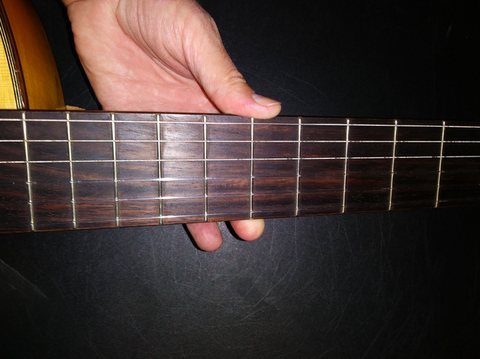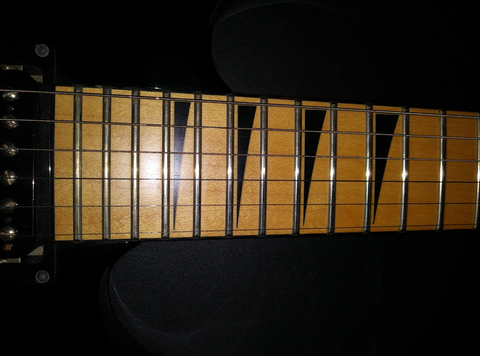 by Jay Gordon - GSR Staff Writer
by Jay Gordon - GSR Staff Writer
When you buy a new guitar, or new car, you expect it to be perfect, right? After all, the factory has people that quality check these babies before shipping them off for sale, yes? Well, not exactly. Read on to find out about serious flaws with new instruments that should never be acceptable.

Why Any Flaws At All
Over the past four decades most manufacturing has shifted from the USA, to Japan, and then to the rest of Asia. While you can still get good guitars out of Asia, its sad to see how quality can really suffer in brand new guitars, even pricey ones. The answer lies in quality control and the pressure to put out many instruments at the lowest price possible. Plus there are many more guitar manufacturers in existence today, meaning there are cheaper alternatives. So even the big name brand companies are under pressure to make the same guitar they did decades ago for cheaper than ever. Something has to give! Unfortunately, its often quality, as instruments get passed through that quite possibly could have been factory seconds (rejects) in a prior era. In this article we call these common flaws “hidden”, because they are usually hard to spot and escape the eye of most guitarists (this list also applies to used guitars). Here’s how to spot some of these problems so you’re not left with a flawed instrument.
Flaw #1 – Sharp Frets
Sharp minds, sharp cheddar cheese, and sharp pencils are all ideal. Sharp frets are certainly not! Some brand new guitars, even $1000 ones, come with sharp frets. I’ve seen it as recent as the date of this writing. To check, simply run your thumb and middle finger simultaneously along the edges of the fretboard as you move up and down the entire length of the neck. If you feel sharp frets, this signals a problem.
 There are two scenarios: 1) The frets weren’t properly finished at the factory, out of sheer laziness or cost-cutting most likely. This is the better of the two situations because its not damaging to the guitar. You can either live with it, or have the frets ends smoothed out. The other scenario is: 2) The guitar got too hot somewhere in transit or storage - Yikes! With this scenario, the guitar may have been exposed to heat or extreme dryness for a considerable time (under 20% humidity or worse, or high temperatures in a closed space for awhile, like a truck, which can dry out the wood). If this happened, the neck may have actually shrunk a tiny amount as the wood contracted. Why is this? Because all wood contains some water, even aged wood for guitars. Many necks are unfinished with exposed wood that will absorb and release moisture subject to the local relative humidity. In an extremely hot or dry environment, a guitar can lose moisture. In many cases the guitar will ‘come back’ after proper humidity levels are restored, but if it got really hot the wood can permanently shrink as some of the cells collapse, and restoring proper humidity will not undo the damage.
There are two scenarios: 1) The frets weren’t properly finished at the factory, out of sheer laziness or cost-cutting most likely. This is the better of the two situations because its not damaging to the guitar. You can either live with it, or have the frets ends smoothed out. The other scenario is: 2) The guitar got too hot somewhere in transit or storage - Yikes! With this scenario, the guitar may have been exposed to heat or extreme dryness for a considerable time (under 20% humidity or worse, or high temperatures in a closed space for awhile, like a truck, which can dry out the wood). If this happened, the neck may have actually shrunk a tiny amount as the wood contracted. Why is this? Because all wood contains some water, even aged wood for guitars. Many necks are unfinished with exposed wood that will absorb and release moisture subject to the local relative humidity. In an extremely hot or dry environment, a guitar can lose moisture. In many cases the guitar will ‘come back’ after proper humidity levels are restored, but if it got really hot the wood can permanently shrink as some of the cells collapse, and restoring proper humidity will not undo the damage.
 Since metal frets don’t shrink under these same harsh conditions, the result is sharp frets as a tiny amount of the fret now protrudes past the neck width. This is a problem because you won’t know what other damage has been done or could manifest with the guitar neck or body down the road as a result of extreme climate exposure. (Quick side story – as a teen I wore soft contact lenses. One morning after a late night concert I discovered I missed placing one of my lenses back in the case within liquid solution. There it sat on the counter, dried up like a potato chip, its edges ruffled and damaged. Every fraction of water was gone from the lens, revealing the clear poly material shriveled like a tiny grape in the Sahara sun. Surprisingly after a few hours in the wet case, it sprung back to life and almost looked like the other lens. Trouble is, it was warped and although I could get it in my eye and see out of it, it never felt the same.)
Since metal frets don’t shrink under these same harsh conditions, the result is sharp frets as a tiny amount of the fret now protrudes past the neck width. This is a problem because you won’t know what other damage has been done or could manifest with the guitar neck or body down the road as a result of extreme climate exposure. (Quick side story – as a teen I wore soft contact lenses. One morning after a late night concert I discovered I missed placing one of my lenses back in the case within liquid solution. There it sat on the counter, dried up like a potato chip, its edges ruffled and damaged. Every fraction of water was gone from the lens, revealing the clear poly material shriveled like a tiny grape in the Sahara sun. Surprisingly after a few hours in the wet case, it sprung back to life and almost looked like the other lens. Trouble is, it was warped and although I could get it in my eye and see out of it, it never felt the same.)
Since the two scenarios above are hard to differentiate between, it’s our opinion to not buy this guitar and if you did buy it, try to return it!
Flaw #2 – body cracks around neck joint
This escapes most guitar inspections, because the average person doesn’t know look at the painted body area that joins the neck. Or, as in our photo, the crack actually looks like a scratch, but indeed is a crack.  Without the bright light in the photo, the crack is hardly visible. Yet hairline cracks are common here on some guitars, signaling that the neck was put under stress at some point. Could have happened during shipping, or the guitar could have fallen (one way to tell if the flaw is a scratch or a crack, see if the line goes over more than just one surface: if the line proceeds into the small joint edge like a road going over a hill, it is most likely a crack). If it's not severe it may not matter, but it’s possible it is a sign of deeper stress in the wood, or it could result in paint chipping off down the road. Sounds like fun, right? Hairline cracks aren’t usually the end of the world, but why not buy a guitar without them?
Without the bright light in the photo, the crack is hardly visible. Yet hairline cracks are common here on some guitars, signaling that the neck was put under stress at some point. Could have happened during shipping, or the guitar could have fallen (one way to tell if the flaw is a scratch or a crack, see if the line goes over more than just one surface: if the line proceeds into the small joint edge like a road going over a hill, it is most likely a crack). If it's not severe it may not matter, but it’s possible it is a sign of deeper stress in the wood, or it could result in paint chipping off down the road. Sounds like fun, right? Hairline cracks aren’t usually the end of the world, but why not buy a guitar without them?
Flaw #3 – Severe bowed neck
Some guitars arrive at the dealer with massively bowed necks. While this alone isn’t a problem, you do have to make sure the guitar can be corrected. There are rare times that the bow is so severe that you can’t remove it with a normal truss rod adjustment.  This is worsened if the guitar is left in this condition for many months or years. Some cheaper guitars have lame truss rods that won’t adjust fully, so a new guitar with a bad neck could be a blow (bow?) you can't recover from. Once again we have seen brand new guitars nearing $1000 with bowed necks so severe that adjusting within the mechanical limits of the truss rod were just barely enough to remove them. Trouble is, if the neck bows further, you’re out of luck. At best you’re stuck with a semi-playable guitar with high action. At worst, you can put a twine cord on the neck and wait for Bow Hunting Season.
This is worsened if the guitar is left in this condition for many months or years. Some cheaper guitars have lame truss rods that won’t adjust fully, so a new guitar with a bad neck could be a blow (bow?) you can't recover from. Once again we have seen brand new guitars nearing $1000 with bowed necks so severe that adjusting within the mechanical limits of the truss rod were just barely enough to remove them. Trouble is, if the neck bows further, you’re out of luck. At best you’re stuck with a semi-playable guitar with high action. At worst, you can put a twine cord on the neck and wait for Bow Hunting Season.
Flaw #4 – Paint and Finish Issues
One thing that should never be wrong with a new guitar is the paint. After all, a new-in-box guitar shouldn’t have dings, nicks, bubbles, and other paint flaws that should’ve been addressed at the factory. Once again, cutting costs and pressure to produce guitars at insanely low cost levels is to blame. This is more of an issue on cheaper Asian made guitars under $500, but any guitar these days can have finish flaws. Look it over really well, scope out things like uneven paint (faded or dark light regions on the same guitar), bubbles, and over-spray. Some minor finish flaws can be rubbed or buffed out, such as with our Guitar Scratch Remover products. Other finish issues like flaws sealed beneath the clearcoat or bad paint are permanent, and you’ll be married to them for as long as you own the guitar (or until death do you part).
Flaw # 5 Strings Misaligned over Neck or Pickups
Uneven strings are another really hard one to spot; you have to be looking for it to notice. But it’s very important. We’re talking about strings that are too close to the edge of the fretboard, especially in the higher registers near the high E string (string #1). Strings should travel straight from the nut over the length of the neck to the bridge, and should not be significantly closer to one edge of the fretboard than the other that they affect proper playing. Notice the photo of the neck with black shark tooth inlays - see how the strings are evenly distributed over the neck, the 1st and 6th string are pretty equal in distance from the neck edges? This is what proper alignment should look like.  They especially should not be at an angle so that they get closer to the neck edge when approaching the higher frets. Why is this a problem? If the strings are too close to the fingerboard edge in the higher registers, you may have buzzing and feel fretted notes sliding off the fretboard, while you bend or play the 1st string. If I had to choose, I’d rather have my strings slightly closer to the 6th String edge of the neck than the 1st String edge. Sadly, I’ve rejected brand new guitars that I otherwise loved because the strings were way too close to the edge of the neck on the 1st String. The cause of this is an incorrectly set neck or bridge at the factory. Even a fraction of a millimeter can cause unevenness across the neck. A little is ok, it’s just visually annoying – but some guitars are off by a lot and there is no easy fix for this. If you don’t play or solo at the higher frets you probably have nothing to worry about, but this is something most guitarists miss when inspecting a new guitar.
They especially should not be at an angle so that they get closer to the neck edge when approaching the higher frets. Why is this a problem? If the strings are too close to the fingerboard edge in the higher registers, you may have buzzing and feel fretted notes sliding off the fretboard, while you bend or play the 1st string. If I had to choose, I’d rather have my strings slightly closer to the 6th String edge of the neck than the 1st String edge. Sadly, I’ve rejected brand new guitars that I otherwise loved because the strings were way too close to the edge of the neck on the 1st String. The cause of this is an incorrectly set neck or bridge at the factory. Even a fraction of a millimeter can cause unevenness across the neck. A little is ok, it’s just visually annoying – but some guitars are off by a lot and there is no easy fix for this. If you don’t play or solo at the higher frets you probably have nothing to worry about, but this is something most guitarists miss when inspecting a new guitar.
A secondary issue with misaligned necks that sometimes the strings do not pass directly over the pickup poles. Visually annoying as well, this is less of an issue because the generous magnetic field of the pickups usually makes up for any variance here. If you can at all compare the guitar to another new one at the store, you may be surprised to find how one is right on the money while the other is off a bit.
There you have it, some major flaws that can be avoided with a keen eye. Thanks for reading, and give that next guitar a double-take to make sure it's a good one. JG
Speaking of flaws, did you know the Player’s Kit Guitar Scratch Remover set can remove forever many scratches and minor surface issues? Why not pick up your kit today, and keep that new guitar of yours looking new for a long time to come.

